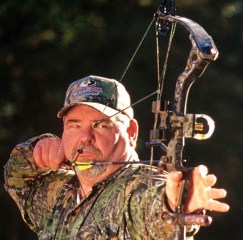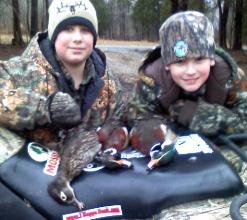Ronnie Strickland with John Phillips | October 11, 2010
 Maybe 90-percent of the reasons why good bowhunters don’t take a deer is due to the noise factor. To learn how much noise you’re making: Oil and grease your tree stand. Then climb in that stand. Next move around in it to make sure it doesn’t squeak when a deer’s in close, and you’re ready to take the shot.
Maybe 90-percent of the reasons why good bowhunters don’t take a deer is due to the noise factor. To learn how much noise you’re making: Oil and grease your tree stand. Then climb in that stand. Next move around in it to make sure it doesn’t squeak when a deer’s in close, and you’re ready to take the shot.
Think about squeaky arrows or cams. At one time I used furniture polish on my arrows to make them so slick that they wouldn’t make any noise when I drew back my bow. Today Scorpion Venom makes an arrow-release fluid. If you put that on your arrows, not only will those arrows not make noise when they come across your rest, they’ll be so slick you may not be able to hold on to them. I’ve found that this product makes my draw absolutely silent. Scorpion Venom also makes a lube oil to keep your cams silent. Deer will hear you in a heartbeat when you draw a bow if it’s got any squeak in it.
Some other tips that will improve your bowhunting include: Shortening your draw length. I always set-up my bow 1/2-inch shorter than my draw length. If you’re squatting down in a tree stand, kneeling on the ground or turning around in the stand to make the shot, you don’t really have time to think about form. You have to spend all of your thinking time looking for that pin sight and making sure you’ve got your pin on the spot on the deer that you want to hit. When I draw my bow back, I don’t want to have to think about whether my shoulders are relaxed, my toes are pointed the right way or any other elements related to form. I just want to be sure I have the string all the way to the back wall and my pin sight where I want my arrow to land to make the shot. I want my bow to be comfortable enough for me to shoot, so I don’t have to worry about form. Setting my bow up 1/2-inch shorter than my draw length means that when I hit that back wall I know that string is all the way back. Then all I have to do is aim and shoot.
Using a kisser button and a peep sight. With these two devices, I know that my form’s right when I get the string back to where it’s supposed to be. Too, I quickly and easily can tell that I’ve got my anchor points set, and my body lined-up. I also should be able to see where the arrow will land.
Betting on your first strike. I like to put my tree stands up 3-4 weeks in advance of the opening of bowhunting season, especially if I’m using a ladder stand. But I’ve had the most luck by going to the spot that I’m hunting and going up a tree with a climbing tree stand on the day I’m hunting from that place. I want to get my tree stand up above the deer’s line of sight, and I prefer to be in a place that deer has no reason to expect me to be. The first time you put a tree stand up is when your odds of taking an older-age-class buck will be best from that stand.
Covering-up. Your face and hands are the parts of your body that a deer is most likely to spot. If you get in a tree stand and are ready to put-on your headnet or gloves but are missing those, then you can paint-up like old-school bowhunters did before the advent of gloves and headnets, if you keep face paint in your daypack. Too, I like to pull my headnet on and put face paint on my face around my eyes to disguise the pale skin that may show through the eye holes.
Not being a muscle man. Successful bowhunting isn’t about how strong you are. It’s about how accurately you shoot. I realize some bowhunters shoot 60, 70 and 80 pounds. But my bow’s set on 58 pounds, because I want to be able to draw my bow by pushing the bow straight away from me, not by sticking my arrow straight up in the air, pulling and pushing to get the arrow back and then bringing my bow down to aim at the target. Then you can draw quieter and with less motion than if you have to go through a gymnastic move to get your bow to full draw. Today’s bows are so fast that you don’t have to shoot 70- or 80-pound bows to deliver the arrow quickly. I’ve shot all the way through a 700-pound elk with my bow set at 58 pounds.
Not “mamping” the deer. If you watch the bowhunting pros on TV when a deer’s walking, to stop the deer, they’ll say the word “mamp,” trying to sound like a bleat. However, when you mamp a deer, the deer automatically will know something is wrong. To solve this problem, I cut shooting lanes. Then the deer will stop just before or just as he passes a shooting lane. When a deer drops down before he jumps, many people call that jumping the string. But the deer’s just dropping-down to spring-away from the danger it’s heard. If you mamp a deer, it will drop-down deeper and quicker than if you don’t mamp it. If the deer doesn’t stop where I want it to, I may shush it or give a low whistle, because I don’t want to startle a deer before I take a shot at it.
Editor’s Note: Ronnie “Cuz” Strickland of West Point, Mississippi, the vice president of Mossy Oak in charge of TV and video production, for many years has picked productive tree-stand sites for himself as well as for the hunters and the cameramen who film Mossy Oak’s TV programs and videos.






























